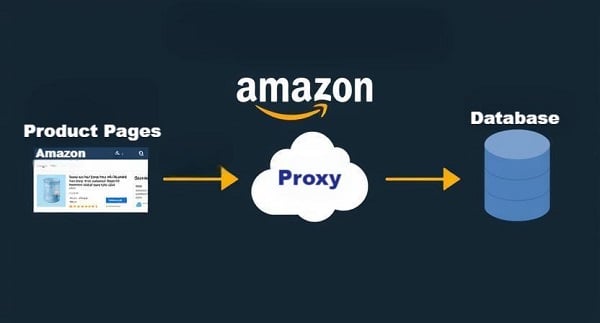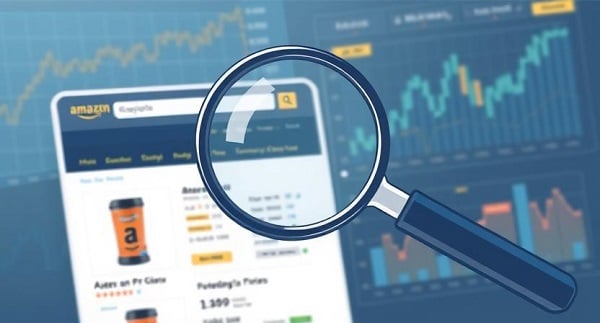Complete Guide to Proxy Servers for PS4 & PS5: Setup, Use Cases & Pro Tips
Complete PS4/PS5 proxy guide: setup steps, when proxies help, troubleshooting, and advanced tips for low-latency gaming.
Nov 10, 2025
Guide on using proxies for real-time Amazon US price monitoring, overcoming IP restrictions, with technical steps for developers.
Reuters reported that Amazon’s first-quarter cloud revenue growth fell below expectations, partly due to uncertainties from new U.S. tariffs impacting retail operations, prompting e-commerce managers to intensify price monitoring to stay competitive. This development highlights the critical need for real-time price tracking on Amazon US, where dynamic pricing and regional restrictions challenge pricing analysts and e-commerce managers.
Amazon’s sophisticated systems often block or throttle IP addresses engaged in frequent price scraping, limiting access to accurate data. Rotating residential proxies and datacenter proxies offer a robust solution, enabling seamless, high-speed price monitoring while bypassing IP restrictions.
This article provides a comprehensive, technical guide for developers and analysts, detailing how to implement proxy solutions, addressing user needs, overcoming challenges, and offering unique insights to ensure effective price tracking for Amazon US.
E-commerce managers and pricing analysts rely on real-time price data to optimize pricing strategies, monitor competitors, and maximize profitability on Amazon US. With millions of products and dynamic pricing algorithms adjusting prices multiple times daily, staying ahead requires frequent data scraping.
However, Amazon employs stringent anti-bot measures, including IP blocking, CAPTCHA challenges, and rate limiting, to deter automated scraping. These restrictions are particularly stringent for non-US IP addresses or repetitive requests from a single IP, creating barriers for global teams or those scaling operations.
The consequences of restricted access are significant. Delayed or incomplete price data can lead to misinformed pricing decisions, lost sales, or reduced competitiveness.
For developers tasked with building or maintaining price monitoring systems, these anti-bot measures pose technical challenges that demand scalable solutions. Proxies address these issues by rotating IP addresses, mimicking organic user behavior, and ensuring uninterrupted access to Amazon’s pricing data.

Proxies act as intermediaries, routing requests through different IP addresses to mask the user’s original IP.
For example, GoProxy’s rotating residential proxies, sourced from real residential networks, are highly effective for Amazon due to their authenticity and low detection risk.
GoProxy is a leading proxy service provider offering rotating residential proxies and datacenter proxies for web scraping and data collection. It ensures high-speed, anonymous, and reliable access for e-commerce price monitoring and other applications. Its solutions integrate seamlessly with tools like Scrapy and Python, supporting developers and businesses globally.
Includes a 7-day trial for platform testing, automatically renewed monthly during the trial period. Sign up to get it today!
Similarly, datacenter proxies, known for their speed and scalability, suit high-frequency scraping tasks.
These proxies enable:
● IP Anonymity: Each request appears to originate from a unique IP, reducing the risk of blocks.
● Geo-Targeting: Proxies allow access to region-specific pricing, critical for US-focused monitoring.
● High-Speed Scraping: Proxies distribute requests across multiple IPs, bypassing rate limits.
● Session Continuity: Proxies maintain stable connections, ensuring consistent data retrieval.
Scraping Amazon US prices without proxies presents several technical obstacles.
Amazon’s anti-bot systems analyze signals such as:
1. IP Request Frequency: High-frequency requests from a single IP trigger rate limits or bans.
2. Device Fingerprinting: Amazon tracks browser configurations, cookies, and user agents to detect automation.
3. Geo-Restrictions: Non-US IPs may face CAPTCHAs or restricted access to US-specific pricing.
4. Behavioral Anomalies: Repetitive or non-human request patterns prompt scrutiny.
For developers, these challenges are compounded when scaling scraping operations, as increased request volumes amplify detection risks. Without proxies, maintaining reliable data pipelines becomes costly and inefficient, requiring manual IP switching or dedicated servers.

GoProxy’s rotating residential proxies and datacenter proxies are tailored for price monitoring.
Below is a detailed guide for developers to implement these proxies, ensuring efficient and scalable data collection.
GoProxy offers two primary proxy types for Amazon price monitoring:
● Rotating Residential Proxies: These IPs, tied to real residential connections, are ideal for evading detection due to their high legitimacy. They suit long-term, high-volume scraping tasks.
● Datacenter Proxies: These IPs, hosted in data centers, offer superior speed and cost-efficiency, making them suitable for rapid, large-scale scraping with lower anonymity requirements.
**Note: For Amazon US price monitoring, rotating residential proxies are recommended for their low ban risk and ability to mimic organic traffic. Datacenter proxies are effective for high-speed tasks with less stringent anonymity needs.
Developers typically use scraping tools like Scrapy, BeautifulSoup, or custom Python scripts to monitor Amazon prices. GoProxy’s proxies support HTTP, HTTPS, and SOCKS5 protocols, ensuring compatibility. Here’s how to configure them:
1. Obtain Proxy Credentials: Access GoProxy’s dashboard to retrieve proxy IP addresses, ports, usernames, and passwords.
2. Integrate with Scraping Tools: In tools like Scrapy, configure the proxy middleware with GoProxy’s details. For example, in Python with requests:
import requests
proxy = {
"http": "http://username:password@proxy_ip:port",
"https": "http://username:password@proxy_ip:port"
}
headers = {
"User-Agent": "Mozilla/5.0 (Windows NT 10.0; Win64; x64) Chrome/91.0.4472.124"
}
response = requests.get("https://www.amazon.com/dp/B08J5V7X7Z", proxies=proxy, headers=headers)
print(response.text) # Returns product page HTML
3. Test Connectivity: Verify proxy functionality by checking the returned IP using https://api.ipify.org. Ensure requests route through the proxy IP.
4. Enable IP Rotation: For rotating residential proxies, configure rotation intervals (e.g., every 10 seconds) via GoProxy’s API to minimize detection risks.
To ensure reliable price monitoring, developers should adopt best practices:
● Mimic Human Behavior: Use randomized delays (e.g., 1–5 seconds) between requests and vary user agents to emulate organic browsing.
● Monitor Proxy Performance: Leverage GoProxy’s dashboard to track uptime, latency, and request success rates, replacing underperforming proxies promptly.
● Geo-Target US Proxies: Select US-based rotating residential proxies to access US-specific pricing without triggering geo-restrictions.
● Limit Concurrent Requests: Cap simultaneous requests per proxy (e.g., 10–20 for datacenter proxies) to avoid rate limits.
For large-scale price monitoring, GoProxy’s proxy pools distribute requests across thousands of IPs, ensuring scalability. Rotating residential proxies are particularly effective for scraping thousands of products daily, as they cycle IPs dynamically to evade detection.
Developers can use GoProxy’s API to automate proxy management, integrating with tools like Scrapy for continuous data pipelines.
| Task | Recommended Proxy | Key Benefit |
| High-Volume Price Scraping | Rotating Residential Proxies | Low detection risk, high anonymity |
| Rapid Price Checks | Datacenter Proxies | High speed, cost-efficient |
| Geo-Specific Price Monitoring | Rotating Residential Proxies | Access to US-specific pricing |
A key insight from GoProxy’s expert is the importance of “hybrid proxy strategies.” For Amazon price monitoring, combining rotating residential proxies for high-anonymity tasks (e.g., scraping competitor prices) with datacenter proxies for rapid, low-priority tasks (e.g., checking stock availability) optimizes both speed and cost. This approach ensures scalability while minimizing ban risks. Custom Web Data Scraping Solutions - Free Demo Available
Another consideration is the ethical use of proxies. Developers must comply with Amazon’s terms of service, focusing on legitimate price monitoring rather than aggressive scraping that could disrupt platform operations. GoProxy provides clean IPs to support compliant usage, reducing the risk of blacklisting.
Developers face concerns such as:
● IP Bans: Amazon may block overused IPs. GoProxy’s rotating residential proxies cycle IPs frequently, mitigating this risk.
● Latency: Proxies can introduce delays. Datacenter proxies offer low-latency performance for high-speed scraping.
● Cost Efficiency: Scaling proxy usage can be expensive. GoProxy’s flexible plans allow starting with small pools and expanding as needed.
Proxies assign unique IPs to each request, mimicking organic traffic. GoProxy’s rotating residential proxies cycle IPs frequently, reducing detection risks. Users should use randomized delays and varied user agents to enhance stealth.
Challenges include compatibility, latency, and IP management. GoProxy supports HTTP, HTTPS, and SOCKS5 protocols for compatibility. User can monitor latency via GoProxy’s dashboard and automate IP rotation to maintain performance.
GoProxy allows selection of US-based rotating residential proxies, ensuring access to US pricing without geo-restrictions. Verify IP geolocation using tools like api.ipify.org for accuracy.
If a proxy is blocked, developers can switch to a new IP from GoProxy’s pool. Rotating residential proxies minimize this risk by cycling IPs automatically. Regular health checks via GoProxy’s dashboard help replace underperforming IPs.
Start with a small proxy pool and scale based on request volume. GoProxy’s flexible plans support cost-effective expansion, and datacenter proxies offer affordable high-speed options for less sensitive tasks. Also offer Custom Web Data Scraping Solutions, free demo available.
< Previous
Next >
 Cancel anytime
Cancel anytime No credit card required
No credit card required